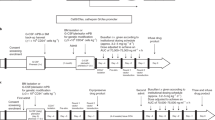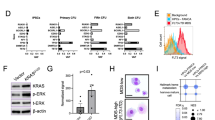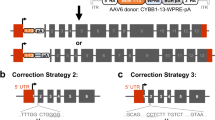Abstract
Gene-modified autologous hematopoietic stem cells (HSC) can provide ample clinical benefits to subjects suffering from X-linked chronic granulomatous disease (X-CGD), a rare inherited immunodeficiency characterized by recurrent, often life-threatening bacterial and fungal infections. Here we report on the molecular and cellular events observed in two young adults with X-CGD treated by gene therapy in 2004. After the initial resolution of bacterial and fungal infections, both subjects showed silencing of transgene expression due to methylation of the viral promoter, and myelodysplasia with monosomy 7 as a result of insertional activation of ecotropic viral integration site 1 (EVI1). One subject died from overwhelming sepsis 27 months after gene therapy, whereas a second subject underwent an allogeneic HSC transplantation. Our data show that forced overexpression of EVI1 in human cells disrupts normal centrosome duplication, linking EVI1 activation to the development of genomic instability, monosomy 7 and clonal progression toward myelodysplasia.
This is a preview of subscription content, access via your institution
Access options
Subscribe to this journal
Receive 12 print issues and online access
$209.00 per year
only $17.42 per issue
Buy this article
- Purchase on Springer Link
- Instant access to full article PDF
Prices may be subject to local taxes which are calculated during checkout





Similar content being viewed by others
References
Cavazzana-Calvo, M. et al. Gene therapy of human severe combined immunodeficiency (SCID)-X1 disease. Science 288, 669–672 (2000).
Aiuti, A. et al. Correction of ADA-SCID by stem cell gene therapy combined with nonmyeloablative conditioning. Science 296, 2410–2413 (2002).
Gaspar, H.B. et al. Gene therapy of X-linked severe combined immunodeficiency by use of a pseudotyped gammaretroviral vector. Lancet 364, 2181–2187 (2004).
Gaspar, H.B. et al. Successful reconstitution of immunity in ADA-SCID by stem cell gene therapy following cessation of PEG-ADA and use of mild preconditioning. Mol. Ther. 14, 505–513 (2006).
Aiuti, A. et al. Gene therapy for immunodeficiency due to adenosine deaminase deficiency. N. Engl. J. Med. 360, 447–458 (2009).
Hacein-Bey-Abina, S. et al. LMO2-associated clonal T cell proliferation in two patients after gene therapy for SCID-X1. Science 302, 415–419 (2003).
Hacein-Bey-Abina, S. et al. A serious adverse event after successful gene therapy for X-linked severe combined immunodeficiency. N. Engl. J. Med. 348, 255–256 (2003).
Howe, S.J. et al. Insertional mutagenesis combined with acquired somatic mutations causes leukemogenesis following gene therapy of SCID-X1 patients. J. Clin. Invest. 118, 3143–3150 (2008).
Hacein-Bey-Abina, S. et al. Insertional oncogenesis in 4 patients after retrovirus-mediated gene therapy of SCID-X1. J. Clin. Invest. 118, 3132–3142 (2008).
Dinauer, M.C. The respiratory burst oxidase and the molecular genetics of chronic granulomatous disease. Crit. Rev. Clin. Lab. Sci. 30, 329–369 (1993).
Roos, D. The genetic basis of chronic granulomatous disease. Immunol. Rev. 138, 121–157 (1994).
Segal, A.W. The NADPH oxidase and chronic granulomatous disease. Mol. Med. Today 2, 129–135 (1996).
Malech, H.L. & Hickstein, D.D. Genetics, biology and clinical management of myeloid cell primary immune deficiencies: chronic granulomatous disease and leukocyte adhesion deficiency. Curr. Opin. Hematol. 14, 29–36 (2007).
Ott, M.G. et al. Correction of X-linked chronic granulomatous disease by gene therapy, augmented by insertional activation of MDS1–EVI1, PRDM16 or SETBP1. Nat. Med. 12, 401–409 (2006).
Fears, S. et al. Intergenic splicing of MDS1 and EVI1 occurs in normal tissues as well as in myeloid leukemia and produces a new member of the PR domain family. Proc. Natl. Acad. Sci. USA 93, 1642–1647 (1996).
Hamaguchi, H. et al. Establishment of a novel human myeloid leukaemia cell line (HNT-34) with t(3;3)(q21;q26), t(9;22)(q34;q11) and the expression of EVI1 gene, P210 and P190 BCR/ABL chimaeric transcripts from a patient with AML after MDS with 3q21q26 syndrome. Br. J. Haematol. 98, 399–407 (1997).
Claus, R. & Lubbert, M. Epigenetic targets in hematopoietic malignancies. Oncogene 22, 6489–6496 (2003).
Nolte, F. & Hofmann, W.K. Myelodysplastic syndromes: molecular pathogenesis and genomic changes. Ann. Hematol. 87, 777–795 (2008).
Christiansen, D.H., Andersen, M.K. & Pedersen-Bjergaard, J. Methylation of p15INK4B is common, is associated with deletion of genes on chromosome arm 7q and predicts a poor prognosis in therapy-related myelodysplasia and acute myeloid leukemia. Leukemia 17, 1813–1819 (2003).
Rogakou, E.P., Pilch, D.R., Orr, A.H., Ivanova, V.S. & Bonner, W.M. DNA double-stranded breaks induce histone H2AX phosphorylation on serine 139. J. Biol. Chem. 273, 5858–5868 (1998).
Khanna, K.K. & Jackson, S.P. DNA double-strand breaks: signaling, repair and the cancer connection. Nat. Genet. 27, 247–254 (2001).
Fernandez-Capetillo, O., Celeste, A. & Nussenzweig, A. Focusing on foci: H2AX and the recruitment of DNA-damage response factors. Cell Cycle 2, 426–427 (2003).
Kearns, W.G., Yamaguchi, H., Young, N.S. & Liu, J.M. Centrosome amplification and aneuploidy in bone marrow failure patients. Genes Chromosomes Cancer 40, 329–333 (2004).
Neben, K., Giesecke, C., Schweizer, S., Ho, A.D. & Kramer, A. Centrosome aberrations in acute myeloid leukemia are correlated with cytogenetic risk profile. Blood 101, 289–291 (2003).
Ganem, N.J., Godinho, S.A. & Pellman, D. A mechanism linking extra centrosomes to chromosomal instability. Nature 460, 278–282 (2009).
Dinauer, M.C., Curnutte, J.T., Rosen, H. & Orkin, S.H. A missense mutation in the neutrophil cytochrome b heavy chain in cytochrome-positive X-linked chronic granulomatous disease. J. Clin. Invest. 84, 2012–2016 (1989).
Wang, L., Robbins, P.B., Carbonaro, D.A. & Kohn, D.B. High-resolution analysis of cytosine methylation in the 5′ long terminal repeat of retroviral vectors. Hum. Gene Ther. 9, 2321–2330 (1998).
Frank, O. et al. Tumor cells escape suicide gene therapy by genetic and epigenetic instability. Blood 104, 3543–3549 (2004).
Burns, W.R., Zheng, Z., Rosenberg, S.A. & Morgan, R.A. Lack of specific gamma-retroviral vector long terminal repeat promoter silencing in patients receiving genetically engineered lymphocytes and activation upon lymphocyte restimulation. Blood 114, 2888–2899 (2009).
Metais, J.Y. & Dunbar, C.E. The MDS1–EVI1 gene complex as a retrovirus integration site: impact on behavior of hematopoietic cells and implications for gene therapy. Mol. Ther. 16, 439–449 (2008).
Du, Y., Jenkins, N.A. & Copeland, N.G. Insertional mutagenesis identifies genes that promote the immortalization of primary bone marrow progenitor cells. Blood 106, 3932–3939 (2005).
Calmels, B. et al. Recurrent retroviral vector integration at the MDS1–EVI1 locus in non-human primate hematopoietic cells. Blood 106, 2530–2533 (2005).
Li, Z. et al. Murine leukemia induced by retroviral gene marking. Science 296, 497 (2002).
Modlich, U. et al. Leukemia induction after a single retroviral vector insertion in Evi1 or Prdm16. Leukemia 22, 1519–1528 (2008).
Buonamici, S. et al. EVI1 induces myelodysplastic syndrome in mice. J. Clin. Invest. 114, 713–719 (2004).
Du, Y., Spence, S.E., Jenkins, N.A. & Copeland, N.G. Cooperating cancer-gene identification through oncogenic-retrovirus-induced insertional mutagenesis. Blood 106, 2498–2505 (2005).
Nucifora, G. The EVI1 gene in myeloid leukemia. Leukemia 11, 2022–2031 (1997).
Dreyfus, F. et al. Expression of the Evi-1 gene in myelodysplastic syndromes. Leukemia 9, 203–205 (1995).
Barjesteh van Waalwijk van Doorn-Khosrovani, S et al. High EVI1 expression predicts poor survival in acute myeloid leukemia: a study of 319 de novo AML patients. Blood 101, 837–845 (2003).
Charrin, C. et al. Structural rearrangements of chromosome 3 in 57 patients with acute myeloid leukemia: clinical, hematological and cytogenetic features. Hematol. J. 3, 21–31 (2002).
Lin, P., Medeiros, L.J., Yin, C.C. & Abruzzo, L.V. Translocation (3;8)(q26;q24): a recurrent chromosomal abnormality in myelodysplastic syndrome and acute myeloid leukemia. Cancer Genet. Cytogenet. 166, 82–85 (2006).
Stevens-Kroef, M. et al. Translocation t(2;3)(p15–23;q26–27) in myeloid malignancies: report of 21 new cases, clinical, cytogenetic and molecular genetic features. Leukemia 18, 1108–1114 (2004).
Trubia, M. et al. Characterization of a recurrent translocation t(2;3)(p15–22;q26) occurring in acute myeloid leukaemia. Leukemia 20, 48–54 (2006).
Laricchia-Robbio, L. & Nucifora, G. Significant increase of self-renewal in hematopoietic cells after forced expression of EVI1. Blood Cells Mol. Dis. 40, 141–147 (2007).
Perkins, A.S., Mercer, J.A., Jenkins, N.A. & Copeland, N.G. Patterns of Evi-1 expression in embryonic and adult tissues suggest that Evi-1 plays an important regulatory role in mouse development. Development 111, 479–487 (1991).
Kustikova, O.S. et al. Retroviral vector insertion sites associated with dominant hematopoietic clones mark “stemness” pathways. Blood 109, 1897–1907 (2007).
Senyuk, V. et al. Repression of RUNX1 activity by EVI1: a new role of EVI1 in leukemogenesis. Cancer Res. 67, 5658–5666 (2007).
Chi, Y., Senyuk, V., Chakraborty, S. & Nucifora, G. EVI1 promotes cell proliferation by interacting with BRG1 and blocking the repression of BRG1 on E2F1 activity. J. Biol. Chem. 278, 49806–49811 (2003).
Cattaneo, F. & Nucifora, G. EVI1 recruits the histone methyltransferase SUV39H1 for transcription repression. J. Cell. Biochem. 105, 344–352 (2008).
Spensberger, D. & Delwel, R. A novel interaction between the proto-oncogene Evi1 and histone methyltransferases, SUV39H1 and G9a. FEBS Lett. 582, 2761–2767 (2008).
Spensberger, D. et al. Myeloid transforming protein Evi1 interacts with methyl-CpG binding domain protein 3 and inhibits in vitro histone deacetylation by Mbd3/Mi-2/NuRD. Biochemistry 47, 6418–6426 (2008).
Kondo, Y. et al. Downregulation of histone H3 lysine 9 methyltransferase G9a induces centrosome disruption and chromosome instability in cancer cells. PLoS One 3, e2037 (2008).
Krämer, A., Neben, K. & Ho, A.D. Centrosome replication, genomic instability and cancer. Leukemia 16, 767–775 (2002).
Zhang, Y. et al. MLL5 contributes to hematopoietic stem cell fitness and homeostasis. Blood 113, 1455–1463 (2009).
Heuser, M. et al. Loss of MLL5 results in pleiotropic hematopoietic defects, reduced neutrophil immune function, and extreme sensitivity to DNA demethylation. Blood 113, 1432–1443 (2009).
Madan, V. et al. Impaired function of primitive hematopoietic cells in mice lacking the mixed-lineage-leukemia homolog MLL5. Blood 113, 1444–1454 (2009).
Sebastian, S. et al. MLL5, a trithorax homolog, indirectly regulates H3K4 methylation, represses cyclin A2 expression, and promotes myogenic differentiation. Proc. Natl. Acad. Sci. USA 106, 4719–4724 (2009).
Cartier, N. et al. Hematopoietic stem cell gene therapy with a lentiviral vector in X-linked adrenoleukodystrophy. Science 326, 818–823 (2009).
Schmidt, M. et al. High-resolution insertion-site analysis by linear amplification-mediated PCR (LAM-PCR). Nat. Methods 4, 1051–1057 (2007).
Acknowledgements
We are indebted to K. Bleuel and S. Wehner for contributions and advice during the study; to H. Holtgreve-Grez and B. Schoell for I-FISH and M-FISH analysis, respectively; to H. Konrad Müller-Hermelink for reference pathology; to B. Staehle for quantitative PCR; to M.C. Dinauer (Indiana University School of Medicine) for plasmid gp91phox(P415H) and to H. Kunkel, E. Rudolf, A. Dillmann, R. Kramer, B. Moreno, I. Vogler and L. Chen-Wichmann for assistance during this work. This work was supported by the Bundesministerium für Bildung und Forschung (grant 01GU0507, TP6b), the Chronic Granulomatous Disorder Research Trust, London (grant J4G/04B/GT), the Georg-Speyer-Haus (T300131), the EU (VIth Framework Program, CONSERT), the Research Priority Program 1230 from the Deutsche Forschungsgemeinschaft and, in part, by a grant of the Tumorzentrum Heidelberg/Mannheim to A.J. A.J.T. is also supported by the Wellcome Trust and the Department of Health (HTH/011/025/004). A. Krämer is supported by the Deutsche Krebshilfe (grant 108560). The Georg-Speyer-Haus is supported by the Bundesministerium für Gesundheit and the Hessisches Ministerium für Wissenschaft und Kunst.
Author information
Authors and Affiliations
Contributions
S.S., M.G.O. and M.G. conceived, organized and supervised the study; S.S., A. Kinner, S.S.-S., C.P. and K. Kühlcke performed experiments; B.B., S.T. and R.Y. performed the SNP and methylation arrays and analyzed data; A. Kinner, A. Krämer, C.B., K. Karakaya. and H.G. generated and analyzed data on genomic instability; A.J. performed the I-FISH and M-FISH analysis; S.S.-S. performed the CpG methylation studies; M.G.O., J.S., H.M., G.G., W.-K.H., P.R., B.S., U.K., R.S. and D.H. were responsible for patient care, analyzed materials from the subjects and provided data on these samples; M.S., K.S. and C.v.K. provided data on retroviral integrations sites; A.J.T., R.S., U.K., M.S., C.v.K. and M.G. prepared and wrote the manuscript.
Corresponding author
Ethics declarations
Competing interests
The authors declare no competing financial interests.
Supplementary information
Supplementary Text and Figures
Supplementary Notes, Supplementary Methods, Supplementary Figures 1–9, Supplementary Tables 1–3 (PDF 11311 kb)
Rights and permissions
About this article
Cite this article
Stein, S., Ott, M., Schultze-Strasser, S. et al. Genomic instability and myelodysplasia with monosomy 7 consequent to EVI1 activation after gene therapy for chronic granulomatous disease. Nat Med 16, 198–204 (2010). https://doi.org/10.1038/nm.2088
Received:
Accepted:
Published:
Issue Date:
DOI: https://doi.org/10.1038/nm.2088
This article is cited by
-
Changing trends in the development of AAV-based gene therapies: a meta-analysis of past and present therapies
Gene Therapy (2023)
-
MECOM Deficiency: from Bone Marrow Failure to Impaired B-Cell Development
Journal of Clinical Immunology (2023)
-
Chimeric antigen receptor T cells therapy in solid tumors
Clinical and Translational Oncology (2023)
-
Lentiviral Gene Transfer Corrects Immune Abnormalities in XIAP Deficiency
Journal of Clinical Immunology (2023)
-
EVI1 expression in early-stage breast cancer patients treated with neoadjuvant chemotherapy
BMC Cancer (2022)



